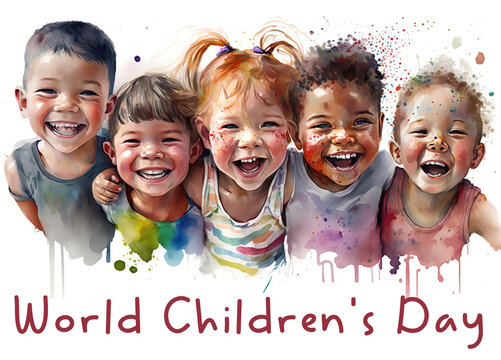
Introduction
World Children’s Day, observed on November 20th each year, is a global celebration of children’s rights and well-being. It serves as a reminder of the importance of nurturing and protecting the youngest members of our society. In this blog, we will explore the significance of World Children’s day Children’s Day, its history, and the various initiatives aimed at empowering children worldwide.
The History of World children’s day Children’s Day
World Children’s Day was established by the United Nations General Assembly in 1954 to promote international togetherness and awareness of children’s rights. Initially celebrated on November 20th, it coincides with the anniversary of the adoption of both the Declaration of the Rights of the Child in 1959 and the Convention on the Rights of the Child in 1989.
The Importance of Children’s Rights
Children’s rights encompass the fundamental entitlements and protections that ensure their holistic development, safety, and well-being. These rights include the right to education, healthcare, protection from violence, and the opportunity to participate in decisions affecting their lives. World Children’s day Children’s Day serves as a platform to raise awareness about these rights and advocate for their implementation.
Global Initiatives to Empower Children
Numerous organizations and initiatives work tirelessly to improve the lives of children worldwide. Here are some notable examples:
- UNICEF: The United Nations Children’s Fund (UNICEF) is a leading organization dedicated to promoting children’s rights and addressing issues such as child labor, child marriage, and access to education and healthcare.
- Save the Children: This international non-governmental organization focuses on child protection, education, and healthcare, working to ensure every child has the opportunity to survive, learn, and be protected from harm.
- Global Partnership for Education (GPE): GPE is a multilateral partnership that supports developing countries in providing quality education to children. It aims to strengthen education systems and remove barriers to learning.
Promoting Children’s Well-being
World Children’s Day encourages individuals, communities, and governments to take action in supporting children’s well-being. Here are some ways to get involved:
- Advocate for children’s rights: Raise awareness about the importance of children’s rights and call for their protection and promotion.
- Support local initiatives: Contribute to local organizations that work towards providing education, healthcare, and protection for children.
- Volunteer or mentor: Offer your time and skills to support children in need. Mentoring programs can have a profound impact on a child’s life.
- Educate children about their rights: Teach children about their rights and empower them to advocate for themselves and others.
Conclusion
World Children’s Day is a significant occasion that highlights the importance of protecting and empowering children worldwide. By raising awareness, supporting initiatives, and advocating for children’s rights, we can contribute to creating a better future for the younger generation. Let us celebrate World Children’s day Children’s Day on November 20th and work towards a world where every child’s potential is realized and their rights are upheld.
FAQs
What is World Children’s Day?
World Children’s Day is a globally recognized observance dedicated to promoting and celebrating children’s rights and well-being. It aims to raise awareness about the importance of ensuring every child’s right to education, healthcare, safety, and protection from discrimination.
Why is World Children’s Day celebrated on November 20th?
The United Nations General Assembly adopted the Convention on the Rights of the Child on November 20th, 1989. This landmark document outlines the fundamental rights of children and serves as the basis for World Children’s day Children’s Day.
What are the key objectives of World Children’s Day?
The primary objectives of World Children’s Day are to advocate for children’s rights, raise awareness about the challenges they face, and promote action to improve their well-being. It provides an opportunity to reflect on progress made and to address ongoing issues.
What are some global initiatives related to World Children’s Day?
Numerous initiatives take place worldwide to mark World Children’s Day. These include events, conferences, campaigns, and educational programs aimed at empowering children, advocating for their rights, and fostering a child-friendly world.
How can individuals and communities celebrate World Children’s Day?
There are several ways to celebrate World Children’s Day. You can organize or participate in local events, donate to organizations supporting children’s rights, volunteer your time and skills, or simply educate yourself and others about the importance of children’s well-being.
Are there any child-friendly activities to enjoy on World Children’s Day?
Yes. You can engage children in fun activities like art projects, storytelling, games, or music that promote values such as empathy, kindness, and inclusion. Encourage children to express their thoughts and dreams and actively listen to their voices.
How can we support children’s rights beyond World Children’s Day?
Supporting children’s rights is a year-round commitment. You can contribute by advocating for quality education, supporting child-focused organizations, raising awareness about child labor and exploitation, and promoting policies that prioritize children’s well-being.
What are some resources for further learning about children’s rights?
To deepen your understanding of children’s rights, you can explore resources such as books, documentaries, and online platforms dedicated to child advocacy. The United Nations Children’s Fund (UNICEF) and non-governmental organizations like Save the Children provide valuable information and materials.
How can professionals contribute to World Children’s Day?
Professionals can play a crucial role in advocating for children’s rights. They can engage in research, policy development, and implementation of programs that support children’s well-being. Sharing knowledge through articles, blogs, and social media can also raise awareness among peers and the public.
How can we ensure children’s rights are protected every day?
Protecting children’s rights requires a collective effort. By promoting inclusive education, ensuring access to healthcare, combating child labor and exploitation, and fostering safe environments, we can create a world where children can thrive and fulfill their potential every day.
